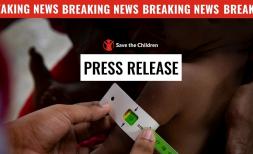Haiti: Quake-affected schools will not be ready for October start date, Save the Children fears

Nephtalie* (14) cradles her sister Gaelle* (18 months) on her lap in the remains of their destroyed house.
Massive destruction, lack of funding threaten children’s access to education and critical psychosocial support.
Schools in Haiti impacted by the August 14 earthquake are unlikely to be ready to safely reopen by October 4, Save the Children is warning exactly one month since the 7.2-magnitude quake destroyed or damaged over 1,060i school buildings.
The organisation is concerned it won’t be possible for proposed school shelters to be built safely in time for the adjusted start date—just three weeks away—in the hardest-hit areas.
Save the Children believes it is vital that children return to school as soon as possible, and is coordinating with the government and other agencies to ensure that children get back to learning and the security of their routine. School is important not only for children’s education but also for their psychosocial recovery after experiencing trauma.
Perpétue Vendredi, Save the Children’s Deputy Country Director in Haiti, said: “Children in Haiti have survived a nightmare event, and the fear and stress continue.
“Many have lost everything—their homes, even family members and friends. Children tell us they struggle to sleep. They desperately need to return to the predictability and support that a school environment provides.”
Even before the earthquake, an estimated 500,000 children were at risk of dropping out of school, ii in many cases due to closures for COVID-19 and insecurity. Save the Children’s Build Forward Betterreport ranked Haiti’s education system in the world’s top 15 most vulnerable, just above Syria and Yemen.
Violence has only worsened since the disaster, and children—many of whom have been living outdoors since their homes were destroyed, or because they’re afraid of aftershocks—have told Save the Children staff members they fear for their safety.
“School is more than a building. Teachers are critical adult figures in children’s lives, identifying protection risks and changes in their mental health needs,” continued Ms Vendredi. “Children will need catch-up classes and support—and schools are an ideal place for them to access the care they deserve.”
As part of its response to the earthquake, Save the Children has proposed building semi-permanent structures until permanent schools are repaired or rebuilt. Save the Children’s structures are accessible to children with disabilities and can stand a minimum of two years. In the meantime, the organisation is prepared to implement child-friendly spaces in affected communities. These offer children a safe place to play, socialise, and get psychosocial support. The spaces would contain designated areas for mothers to breastfeed and care for babies.
Save the Children is planning to support communities with training for teachers, financial assistance, school supplies, and furniture.
The earthquake recovery is also an opportunity to make schools accessible to more children. Many of the buildings that were damaged were not designed for children with disabilities. Rebuilding facilities with all children in mind is vital.
Save the Children is calling on the international community to fully finance Haiti’s humanitarian response, which remains severely underfunded. Education must be prioritised in recovery plans.
Notes to editors:
- Save the Children’s report, Build Forward Better: How the global community must act now was published in September 2021. It includes The Risks to Education Index, which ranks countries on the vulnerability of their school systems for all children, with additional rankings for boys only and girls only. The index consists of nine indicators of risk, grouped into six dimensions.
- Save the Children conducted a rapid assessment of 14 schools it supports with partners SIKSE and PRODEV Haiti in areas affected by the earthquake. Of the 14 facilities:
- 4 were fully destroyed and require complete rebuilding
- 6 need major rehabilitation
- 4 (including 2 built by Save the Children) are structurally sound and safe for children to return to on Oct 4.
[i] UN OCHA Haiti: Earthquake Situation Report No. 4 [Sept. 7, 2021]. https://reliefweb.int/sites/reliefweb.int/files/resources/20210907_SitRep%20no.%204_Haiti%20earthquake.pdf
[ii] UNICEF “Broken childhood in Haiti: Homeless, unable to go to school, hunger, and violence,” August 26, 2021. By Molière Adely, Lucía Baldomir, and Elisa Lieber. https://www.unicef.org/lac/en/stories/broken-childhood-haiti-homeless-unable-to-go-to-school-hunger-and-violence
Content available:




